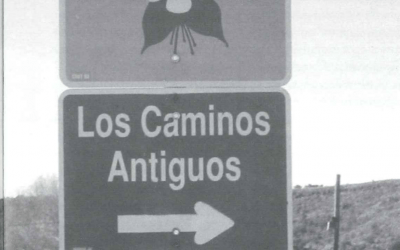Certifying Sustainable Tourism

RICANCIE toursits with guide. Photo courtesy of RICANCIE.
Environmental practices strongly influence the way tourists choose their vacation spots. Increasingly they expect to see methods in place to protect and conserve nature in the areas they visit.
As a response to this growing concern, a group of public and private entities in Costa Rica have joined together to develop a Certification in Sustainable Tourism Program. The Harvard Business School-affiliated Central American Business Administration Institute (INCAE) had a key academic and technical participation during the development and implementation of the program, as did the University of Costa Rica (UCR).
“Sustainable tourism” is the term used to describe policies, practices, and programs that take into account not only tourists’ expectations about responsible management practices, but also the expectations of local communities and the quality of life of their people. For tourism, sustainability is not only a response to the demand factors of the industry; it is an indispensable condition to be able to compete successfully and, even more importantly, to be able to survive over the long run.
Sustainability, as a model for development, refers to the need to satisfy the requirements of today’s society without making it impossible for future generations to satisfy their own. It prescribes that the development of a country cannot be achieved by the unrestrained exploitation of its resources (natural, cultural, social, etc.) to the point of extinguishing or destroying them, seeking to fulfill the needs of the present population (food, housing, health, work, etc.), without recognizing that these resources are the only platform, or potential asset, that the future generations of this country will have to meet their own needs.
Based on this approach, in 1998 the Costa Rican Tourism Institute (CTI) and the Costa Rican National Accreditation Commission (NAC) developed the Certification in Sustainable Tourism (CST) program, that seeks to categorize and certify each tourism company according to the degree to which its operations comply with a model of sustainability (including natural, cultural, and social resource management). In addition to CTI and NAC, the public sector is represented by the Costa Rican Environment & Energy Ministry (MINAE) and the Biodiversity National Institute (InBio). The private sector is represented by the National Tourism Chamber, with the active participation of international organizations such as The Earth Council. Hotels, inns, cabins, and bed & breakfasts services can participate on a voluntary basis without restriction as to their location (beaches, mountains, etc.) or their size. Rating factors fall into four categories: physical-biological environment; facilities and infrastructure; guest relations; and social-economic environment. Very specific questions are posed in each of the categories to measure practical dimensions of sustainability and to score the firm on demonstrated practices.
The CST program provides a system of “sustainability levels” on a scale of 0 to 5, in which each number indicates the relative position of the firm in terms of sustainability. On site inspections by qualified assessors determine the level of compliance and ultimate sustainable tourism classification.
The CST system is designed to include a series of incentives that increase benefits to each company in direct proportion to its increased rating. In other words, as a particular company’s practices become more sustainable, it receives more and better benefits, such as international and national marketing promotion, personnel training, and priority participation in various world tourism events.
The Costa Rican Tourism Institute has identified three main impacts resulting from the development of CST:
For the national tourism industry, CST represents a new form of competition—a new way to differentiate our tourist industry with respect to our competitors, and one which enhances those tourism products which show a commitment to sustainability, opening new possibilities for marketing and international promotion. Moreover, this program directly attacks the problem generated by the unethical behavior of some companies operating as “greenwashers” (abusing the concepts of “eco” and/or “sustainability”), by providing reliable information on the firms that are really making progress in producing a tourist product that is sustainable. Undoubtedly, this will enhance the country’s image as an authentic naturalist tourist destination, thus increasing considerably the competitiveness of our national tourism product.
For the tourism entrepreneur, this program provides the business person with an opportunity for utilizing a new element of competition, based on a new way of differentiating his product, a concept that will be fully reinforced and enhanced in the national and international tourism promotional programs.
The CST motivates tourism executives to improve their use of company resources, promoting savings and their efficient utilization.
TOWARDS AN INTERNATIONAL CST PROGRAM
The World Tourism Organization (WTO) Committee on Sustainable Tourism has been favorably impressed by Costa Rica’s comprehensive, cost-effective Certification in Sustainable Tourism (CST) program and is citing Costa Rica as a model for the effectiveness of certification programs for sustainable tourism.
The critical ingredient in any certification program is summed up in one word: credibility. Those responsible for the CST, particularly ICT’s Natural Resources Department, and INCAE’s Latin American Center for Competitiveness and Sustainable Development are aware of what constitutes a credible system that could be implemented worldwide.
The essential elements of any certification program are part of the process of “conformity assessment” essential for suppliers, consumers, and regulators. It enables conscientious producers to distinguish their products from those made by less reputable ones. It provides consumers with a reliable means to select products in the marketplace and enables government agencies to enforce regulations that protect the public’s health and safety.
The Certification in Sustainable Tourism program in Costa Rica, as well as worldwide, could become a more comprehensive system that addresses all aspects of tourism (see table). Of the more than two dozen eco-tourism certification programs that currently exist, nearly every one is focused exclusively on hotels. But tourism involves much more than hotels.
Some tourism subsectors with potential for sustainable tourism certification
| AIRPORTS | MARINAS | PORT FACILITIES |
| TOUR BOATS | TOUR BUSES | TAXIS |
| BEACHES | RECYCLING CENTERS | DIVE BOATS |
| FOREST SAFARIS | NATURE RESERVES | GOLF COURSES |
| ADVENTURE TOURS | REEF DIVE OPERATIONS | RIVER SAFARIS |
| YACHT CHARTER OPERATIONS | AQUATIC SPORTS CENTERS | ARCHEOLOGICAL SITES |
| TOUR OPERATORS | GUIDES | INFORMATION CENTERS |
| AMUSEMENT PARKS | MUSEUMS |
Source: Toth, R. (2000), Implementing a Worldwide Sustainable Tourism Certification System. Working paper CEN662, INCAE-CLACDS, June 2000
It appears that the most efficient and cost effective way to implement a worldwide CST system is to contract with already accredited national (not the large commercial multinational) certifiers that are motivated to work with, and under the direction of an international CST organization. In the many countries that do not have such organizations it will be necessary to service them directly. Eventually, as the system gains momentum and experience, it may be appropriate in some countries to delegate administration to national or regional “chapters” or affiliated organizations.
The ultimate need is a cost-effective, credible conformity assessment system, not just a certification program. A particular challenge is that, unlike sectors with long established conformity assessment practices, the tourism sector does not yet have in place some of the system components or infrastructure that would expedite implementation of CST. However, there is no need to reinvent the wheel as proven models, and widely-used effective procedures have been amply documented, tested, and implemented worldwide.
Taking into account these and other considerations, INCAE researcher Toth considered some appropriate structures for a global CST system—incorporating those characteristics that engender recognition and acceptance, and benefit from lessons learned at other certification programs. He evaluated the core administrative unit; four approaches for implementing the overall system, and two options for governance. One is a cooperative arrangement with the WTO, and the other a more integrated relationship. He also proposed an International Sustainable Tourism Commission (ISTC)—an autonomous body functioning as an executing agency of the WTO.
Such a system would encourage research and development and facilitate technology transfers, as well as provide training for auditors and certificate applicants. Review and appeal panels would ensure the equity of the certification process. The Conformity Review Panel would assure uniform interpretation and application of CST standards through spot check assessments of facilities that have been certified. It is also responsible for the qualifications of auditors.
An assessment of the pros and cons of the different approaches for awarding certification indicates that no single approach will suffice for certification in all countries of the world because of the lack of infrastructure in some countries which are major tourist destinations, and insufficient market in others to attract commercial certifiers. However, what is clear is that a process of certification makes sustainable tourism more credible and provides an incentive for its development.
Winter 2002, Volume I, Number 2
Lawrence Pratt is associate director of the Latin American Center for Competitiveness and Sustainable Development (CLACDS), an INCAE project based in Costa Rica and funded by the Central American Bank for Economic Integration (CABEI), the AVINA Foundation, and the Central American private sector.
Related Articles
Editor’s Letter: Tourism
Ellen Schneider’s description of Sandinista leader Daniel Ortega in her provocative article on Nicaraguan democracy sent me scurrying to my oversized scrapbooks of newspaper articles. I wanted to show her that rather than being perceived as a caudillo
Recreating Chican@ Enclaves
Centrally located between southern Colorado and northern New Mexico, is a hundred-mile long by seventy-mile wide intermountain basin known as the San Luis Valley. Surrounded on the east …
Tourist Photography’s Fictional Conquest
Recently, while walking across the Harvard campus, I was stopped by two tourists with a camera. They asked me if I would take a picture of them beside the words “HARVARD LAW SCHOOL,” …




